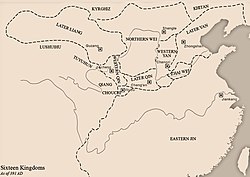Later Liang (Sixteen Kingdoms)
This article needs additional citations for verification. (December 2015) |
Later Liang (後涼) 酒泉 (387–389), 三河 (389–396), 涼 (396–403) | |||||||||||||
|---|---|---|---|---|---|---|---|---|---|---|---|---|---|
| 386–403 | |||||||||||||
 Later Liang in the northwest | |||||||||||||
| Capital | Guzang | ||||||||||||
| Government | Monarchy | ||||||||||||
| Tian Wang | |||||||||||||
• 386–400 | Lü Guang | ||||||||||||
• 400 | Lü Shao | ||||||||||||
• 401–403 | Lü Zuan | ||||||||||||
• 403–406 | Lü Long | ||||||||||||
| History | |||||||||||||
• Established | 386 | ||||||||||||
• Lü Guang's claiming of imperial title | 396 | ||||||||||||
• Southern Liang's and Northern Liang's independence | 397 | ||||||||||||
• Disestablished | 403 | ||||||||||||
• Lü Long's death | 416 | ||||||||||||
| |||||||||||||
| Today part of | China Kyrgyzstan | ||||||||||||
The Later Liang (simplified Chinese: 后凉; traditional Chinese: 後凉; pinyin: Hòu Liáng; 386–403) was a state of the Sixteen Kingdoms during the Jin Dynasty (266–420) in China.[1] It was founded by the Lü family of the Di ethnicity.
All rulers of the Later Liang proclaimed themselves "Heavenly Prince" (Tian Wang).
Rulers of the Later Liang[]

Later Liang rulers in a 14th-century manuscript of Rashid al-Din's world history, the Jami' al-Tawarikh
| Temple name | Posthumous name | Personal name | Duration of reign | Era names |
|---|---|---|---|---|
| Taizu | Yiwu | Lü Guang | 386–400 | Tai'an (太安) 386–389 Linjia (麟嘉) 389–396 Longfei (龍飛) 396–400 |
| – | Lü Shao | 400 | – | |
| – | Ling | Lü Zuan | 400–401 | Xianning (咸寧) 400–401 |
| – | Lü Long | 401–403 | Shending (神鼎) 401–403 | |
Rulers family tree[]
| Later Liang | |||||||||||||||||||||||||||||||||||||||||||||||||||||||||||||||||||||||||||||||||||||||||||||||||||||||||||||||||||||||||||||
|---|---|---|---|---|---|---|---|---|---|---|---|---|---|---|---|---|---|---|---|---|---|---|---|---|---|---|---|---|---|---|---|---|---|---|---|---|---|---|---|---|---|---|---|---|---|---|---|---|---|---|---|---|---|---|---|---|---|---|---|---|---|---|---|---|---|---|---|---|---|---|---|---|---|---|---|---|---|---|---|---|---|---|---|---|---|---|---|---|---|---|---|---|---|---|---|---|---|---|---|---|---|---|---|---|---|---|---|---|---|---|---|---|---|---|---|---|---|---|---|---|---|---|---|---|---|
| |||||||||||||||||||||||||||||||||||||||||||||||||||||||||||||||||||||||||||||||||||||||||||||||||||||||||||||||||||||||||||||
See also[]
- Di (Wu Hu)
- List of past Chinese ethnic groups
- Wu Hu
- Sixteen Kingdoms
- Buddhism in China
- Kumarajiva
- Gansu
- Dunhuang
- Memoirs of Eminent Monks
References[]
- ^ Grousset, Rene (1970). The Empire of the Steppes. Rutgers University Press. pp. 59–60. ISBN 0-8135-1304-9.
Categories:
- Later Liang (Sixteen Kingdoms)
- Dynasties in Chinese history
- Former countries in Chinese history
- 386 establishments
- 4th-century establishments in China
- 5th-century disestablishments in China